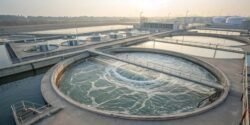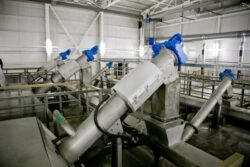Biosolids Wastewater Treatment: A Comprehensive Overview
Introduction
Biosolids wastewater treatment is an essential process in modern waste management that is gaining increased attention due to rising environmental concerns and the push for sustainable practices. Often regarded as a waste product, biosolids—nutrient-rich organic materials generated from the treatment of municipal sewer sludge—can be recycled and repurposed in various beneficial ways. As the global population continues to grow, so does the volume of wastewater produced, presenting significant challenges and opportunities for the management of biosolids. This article delves into the intricacies of biosolids treatment processes, explores the technologies employed, addresses common pain points experienced by wastewater treatment facilities, and highlights the benefits and potential risks of using biosolids.
Understanding Biosolids: Composition and Classification
Biosolids are defined as the byproduct of wastewater treatment processes, consisting of organic matter, nutrients, pathogens, and heavy metals. They can be categorized into several classes based on their treatment and the resulting quality. According to the U.S. Environmental Protection Agency (EPA), biosolids are generally classified into two major categories: Class A and Class B.
-
Class A Biosolids: These biosolids have been treated to significantly reduce pathogens to safe levels, making them suitable for unrestricted use in agriculture, landscaping, and other applications. They must meet stringent standards set by the EPA, often tested through methods such as composting, heat drying, or anaerobic digestion.
- Class B Biosolids: While these remain a viable option for land application, Class B biosolids contain higher pathogen levels and thus require specific handling protocols to mitigate potential health risks. They are often treated using methods like anaerobic digestion but are subject to land application restrictions.
Key Statistics on Biosolids Production
According to recent industry analysis, the United States generates approximately 8 million dry tons of biosolids annually from municipal wastewater treatment plants. A significant portion of this volume—about 56%—is beneficially reused in applications such as agriculture and land reclamation, while the remaining percentages are incinerated or placed in landfills. The potential for these materials to serve as valuable resources rather than simply waste products is a burgeoning field of study among environmental engineers and scientists.
The Treatment Process: Techniques and Technologies
The process of biosolids treatment generally encompasses several stages: preliminary treatment, primary treatment, secondary treatment, and stabilization. Below is a summary of each of these stages along with relevant technologies that can enhance treatment efficacy.
1. Preliminary Treatment
In the preliminary treatment phase, large solids and debris are removed from wastewater through screens and grit chambers to prevent damage to subsequent treatment equipment. This stage is crucial for protecting the infrastructure of the facility and optimizing treatment efficiency.
2. Primary Treatment
During primary treatment, wastewater undergoes sedimentation in large tanks, allowing solid particles to settle and form sludge at the bottom. This primary sludge is rich in organic matter and becomes the foundation for further biosolids production. Current estimates indicate that primary treatment can reduce the volume of solids by approximately 50% on average.
3. Secondary Treatment
Secondary treatment is the heart of wastewater treatment, where biodegradable materials are broken down by microorganisms in aeration tanks. This often involves activated sludge systems, sequencing batch reactors (SBRs), or membrane bioreactor (MBR) systems. This phase can reduce organic material by nearly 90%, resulting in effluent that can either be discharged into water bodies or reused for irrigation after additional treatment.
4. Stabilization and Conditioning
After secondary treatment, the remaining biosolids undergo stabilization, which reduces pathogens and odor. Common stabilization techniques include anaerobic digestion, aerobic digestion, and lime stabilization. Research published in leading environmental engineering journals indicates that anaerobic digestion not only stabilizes biosolids but also reduces their volume by approximately 50% while generating biogas that can be harnessed for energy.
5. Dewatering and Drying
In this final phase, biosolids are dewatered to lower their moisture content before disposal or beneficial use. Mechanical processes like belt filter presses or centrifuges are commonly utilized. Once dewatered, biosolids can be further processed through drying techniques for higher-grade applications.
Addressing Pain Points in Biosolids Management
While the treatment of biosolids presents numerous benefits, facilities managing wastewater treatment are faced with various challenges. Key pain points include:
1. Regulatory Compliance
Navigating the complex landscape of EPA regulations, state laws, and local ordinances can pose significant difficulties for facility managers. Regular monitoring and adherence to safety protocols are paramount, particularly for Class B biosolids that require specific management practices to mitigate human health risks.
2. Public Perception and Acceptance
Negative public perception surrounding biosolids, often stemming from fears about health risks or aesthetic concerns, can hinder beneficial reuse efforts. Effective communication strategies and educational initiatives are crucial in fostering acceptance within communities.
3. Cost-Effectiveness
The financial burden of biosolids management can be a major barrier. Facilities must balance operational costs against the potential for generating revenue through biosolids recycling initiatives. Grant opportunities and partnerships with agricultural sectors may alleviate some financial pressures.
Environmental Benefits and Risks
Benefits of Biosolids Recycling
-
Nutrient Recycling: Biosolids are rich in nitrogen, phosphorus, and organic matter, providing essential nutrients for crops. By recycling these materials into agricultural soils, farmers can improve soil fertility and mitigate the need for chemical fertilizers.
-
Reduced Landfill Usage: By repurposing biosolids, municipalities can significantly decrease their reliance on landfills, which are becoming increasingly limited. Research indicates that biosolids recycling has the potential to divert up to 2 million tons of waste away from landfills annually.
- Energy Generation: The anaerobic digestion process not only stabilizes biosolids but also produces biogas, which can be utilized for electricity and heat generation, reducing energy costs for facilities. As of 2022, about 10% of wastewater treatment plants in the U.S. reported using biogas for energy recovery.
Potential Risks
While there are numerous environmental benefits, potential risks associated with biosolids must also be considered:
-
Pathogen Risks: If not properly treated, biosolids can harbor pathogens that pose a threat to human health and ecosystems.
-
Heavy Metal Contamination: Instances of heavy metals and persistent organic pollutants can enter biosolids through wastewater, raising concern over soil and water quality.
- Community Resistance: Projects aimed at land application or composting biosolids may face public backlash, particularly if local communities do not fully understand the safety and benefits associated with these practices.
Conclusion
Biosolids wastewater treatment represents a vital yet often misunderstood aspect of resource recovery in the context of modern environmental practices. By transforming these byproducts into valuable resources, municipalities can contribute to sustainable agricultural practices, conserve landfill space, and generate renewable energy. However, it is imperative that facility managers remain attuned to regulatory environments, engage with the community, and adopt innovative technologies to address the challenges inherent in biosolids management. As public awareness and understanding of these issues grow, so too will the potential for biosolids to play an essential role in sustainable waste management practices.
The strategic recycling of biosolids ensures that we turn the challenges of wastewater into beneficial opportunities, promoting a circular economy while protecting human health and the environment.
(Note: For proper SEO optimization, the use of keyword tools and analytics would typically be employed to identify high-ranking keywords related to biosolids and wastewater management. This draft aims to provide a structured framework that addresses the key aspects and SEO considerations for search engine visibility.)
source https://www.waterandwastewater.com/biosolids-wastewater-treatment/



No comments:
Post a Comment